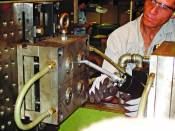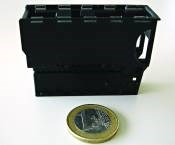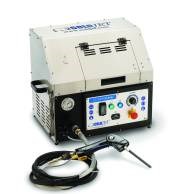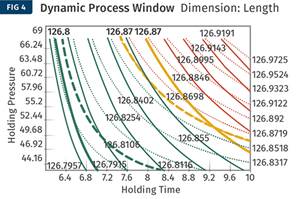Cleaning Molds in the Press Slashes Downtime
For a global electronics manufacturer with around-the-clock production, the ability to clean molds in the press without disassembly provided major productivity increases.
For a global electronics manufacturer with around-the-clock production, the ability to clean molds in the press without disassembly provided major productivity increases. The secret was a dry-ice blast cleaning system designed for use on hot molds and especially suited to multi-cavity tools with small, intricate, or sensitive surfaces.
Tyco Electronics Corp., Berwyn, Pa., is one of the world’s largest suppliers of connectors, relays, switches, circuit-protection devices, and sensors. The company first tested dry-ice mold cleaning at its automotive-parts plants in North Carolina, which had experienced significant downtime with conventional cleaning processes such as ultrasonic cleaning and manual cleaning with solvents. The success of these tests led to introduction of dry-ice blasting to the company’s 15 European automotive electronics plants.
GOOD FOR HIGH-USE MOLDS
The experience of one Tyco Electronics plant in Belgium, which makes airbag connectors and other safety components, exemplifies the efficiency of dry-ice blast cleaning. This plant has more than 300 molds, 10 of which are larger, long-running tools that make products ranging in size from 0.39 in. to 5.9 in. and weighing around 0.18 to 7 oz.
“The injection machines need to run 24 hours a day, yet some of the molds must be cleaned every 48 hours,” says Jan Schotte, manager of plastics process technology for Tyco Electronics Belgium EC N.V. Global Automotive Div. Degraded plastic builds up on the molds during production, causing blemishes on parts and blocking small vents in the molds, which results in burn marks on parts. Such parts typically must be scrapped.
In the past, Tyco used a variety of mold-cleaning methods, including ultrasonics, PTFE particle blasting, solvents, and hand scraping. These methods required an entire cleaning crew for eight to 12 hours to clean a single mold plate.
Before cleaning, the molds and molding machines needed two to four hours to cool down before the molds could be removed. Then the crew was needed to bring the molds from the machine to a separate area for cleaning. Not only were the molds removed from production, but Tyco had to allocate additional workers to the disassembly and cleaning of the molds. Moving the molds around the plant was inefficient and subjected expensive tooling to potential damage.
Tyco Electronics needed a way to clean molds more efficiently. After researching a number of cleaning techniques, Tyco evaluated a dry-ice blast cleaning system from Cold Jet, LLC. Dry-ice blasting removes contaminants from surfaces by accelerating solid particles of recycled CO2 (recovered from manufacturing plants that produce CO2 as a byproduct) through a hose and high-velocity nozzles. These non-abrasive particles create mini explosions when they impact a hard surface. On impact, the solid CO2 particles instantaneously sublimate, or revert to their gaseous form, expanding in volume by 800 times. The combination of kinetic energy and thermal shock breaks the bond between the residue and the surface. The dry ice evaporates and the residue falls away from the surface.
Dry-ice blast cleaning eliminates the cost and inconvenience of secondary waste treatment and disposal required with manual and ultrasonic methods, which use rags with solvents and ultrasonic liquid cleaning solutions. Moreover, dry-ice blasting has been shown to extend the life of tooling by eliminating the wear caused by abrasive cleaning processes and trapped media left behind by other methods. Also, employee safety and morale are enhanced by eliminating harsh chemicals. Perhaps most important, dry-ice blasting can clean molds while they are is still hot and assembled in the press, thereby facilitating regular and thorough cleaning and eliminating prolonged production shutdowns.
QUICK PAYBACK
Tyco’s Belgian plant chose Cold Jet’s i3MicroClean, a lightweight, compact, low-pressure, electric-powered blasting system that uses compressed air (as little as 12 cfm) and shaves a dry-ice block into particles that are blasted at variable air pressures from 50 to 125 psi. The system’s adjustable blast pressure allows users to clean delicate surfaces faster than traditional cleaning methods and without abrasion. The power can be turned up to clean tougher surfaces.
To justify the purchase of the system, Tyco established an 18-month return-on-investment goal. Says Schotte, “We were able to see the benefits immediately, and the system paid for itself in just over a month.” With dry-ice blasting, Tyco can clean the 10 largest, most frequently used molds while they are still hot in the injection molding machines. This cleaning process now takes less than an hour.
According to Schotte, Tyco still uses conventional cleaning methods on some molds. ‘The relatively large surface area of our 10 most commonly used molds made dry-ice blasting the most effective solution, while other molds with more complex cores and vents require a bit more manual attention. In addition to cleaning our large molds faster and more frequently, we no longer need a team of people to help us disassemble, clean, and reassemble molding equipment. The dry-ice blast-cleaning process requires only one person to blast the molds while they are still in the machines.”
To meet European noise and safety standards, Tyco requires operators to wear goggles and earplugs. They must also close off the area being cleaned, and lower the air pressure on the blasting machine to minimize noise without affecting the speed or effectiveness of the cleaning process.
Since the deployment of the dry-ice blast system at the Belgian plant, Tyco has invested in this cleaning technology at 12 other locations in Europe and five in North America.
Related Content
Optimizing Pack & Hold Times for Hot-Runner & Valve-Gated Molds
Using scientific procedures will help you put an end to all that time-consuming trial and error. Part 1 of 2.
Read MoreHow to Select the Right Tool Steel for Mold Cavities
With cavity steel or alloy selection there are many variables that can dictate the best option.
Read MoreHot Runners: A View from the Bottom Up
Addressing hot-runner benefits, improvements, and everyday issues from the perspective of decades of experience with probably every brand on the market. Part 1 of 2.
Read MoreImprove The Cooling Performance Of Your Molds
Need to figure out your mold-cooling energy requirements for the various polymers you run? What about sizing cooling circuits so they provide adequate cooling capacity? Learn the tricks of the trade here.
Read MoreRead Next
Lead the Conversation, Change the Conversation
Coverage of single-use plastics can be both misleading and demoralizing. Here are 10 tips for changing the perception of the plastics industry at your company and in your community.
Read MoreAdvanced Recycling: Beyond Pyrolysis
Consumer-product brand owners increasingly see advanced chemical recycling as a necessary complement to mechanical recycling if they are to meet ambitious goals for a circular economy in the next decade. Dozens of technology providers are developing new technologies to overcome the limitations of existing pyrolysis methods and to commercialize various alternative approaches to chemical recycling of plastics.
Read MoreUnderstanding Melting in Single-Screw Extruders
You can better visualize the melting process by “flipping” the observation point so that the barrel appears to be turning clockwise around a stationary screw.
Read More




























